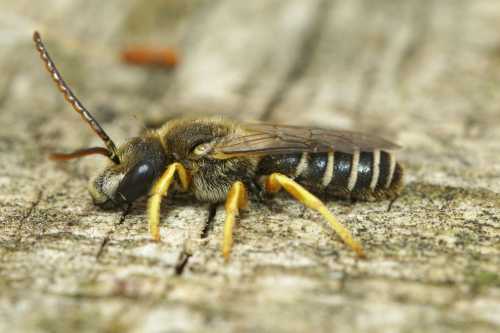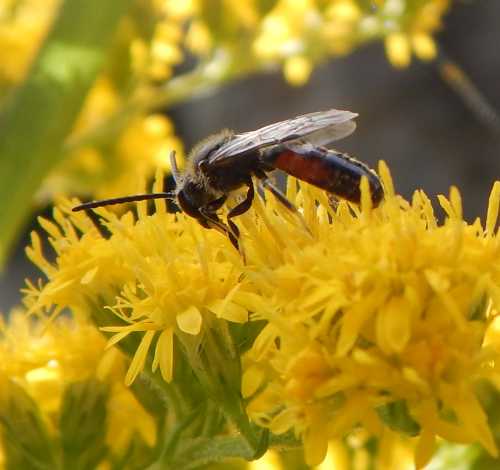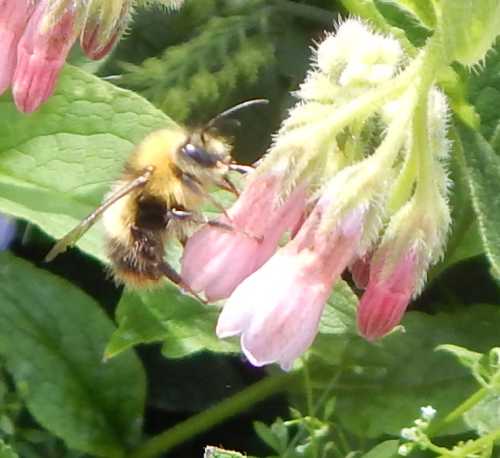Orange-legged Furrow Bee - Halictus rubicundus
Updated: 25th January 2023
From March onwards, look out for this charming little bee, Halictus rubicundus, (commonly known as the Orange-Legged Furrow Bee). Females can fly from March to October, and males, can be seen from June (the photographs on this page were taken in July).
Physical characteristics of the orange-legged furrow bee
From the family HALICTIDAE, the Orange-Legged Furrow Bee can measure up to 10mm in length. Various Lassioglossum species appear similar from photographs, but are smaller bees than Halictus rubicundus.
In the males, the body, is proportionately longer and thinner than is the case with the female Halictus rubicundus and some other solitary bee species.
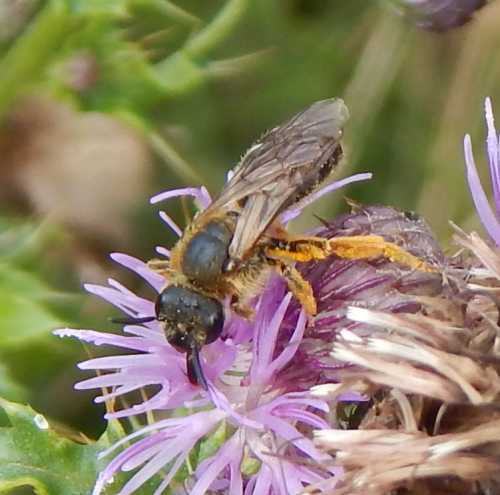 Halictus rubicundus - Orange-Legged Furrow Bee, (female) - note brownish hair on thorax.
Halictus rubicundus - Orange-Legged Furrow Bee, (female) - note brownish hair on thorax.Other key differences between males and females:
- males have quite long antennae, and longer antennae than those of females;
- the pale 'stripes' on the abdomen of the female especially, are well defined, and contrast with the darker body;
- females do not have pollen baskets, but can carry large amounts of pollen on scopa (adapted long hairs) on the rear legs (tibia). See how bees collect pollen;
- they usually show brown hairs on the thorax (upper body), but male specimens can become rather sun-bleached, with thorax hairs turning a greyish hue;
- males have pale legs.
Flowers visited by the Orange-legged furrow bee
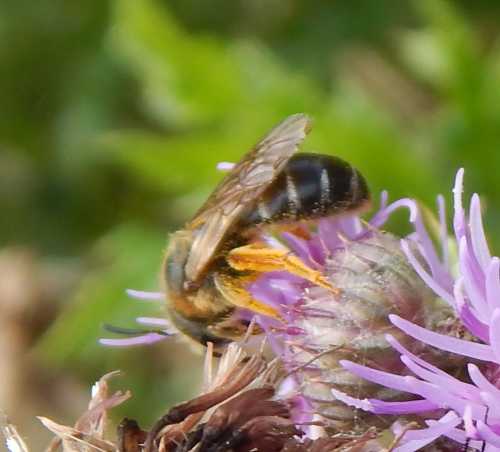 Above: Halictus rubicundus - Orange-legged furrow bee, (female) side view.
Above: Halictus rubicundus - Orange-legged furrow bee, (female) side view.Flowers favoured by these bees include umbellifers, such as Wild Parsnip, though various flowering shrubs and trees may also be visited - they are generalists, and as such, they are important pollinators both in the wild and in gardens.
They pollinate onions, sunflowers and some carrot plants. For garden flowers, various composites and asters are popular.
Among wildflowers, the thistles, Knapweed, heathers, scabiouses, Hemp Agrimony, Cat's-ear are among their favoured sources of pollen and nectar.
If you want to spot this species, look out for Knapweed and thistles along wildflower banks and verges such as the one featured below.
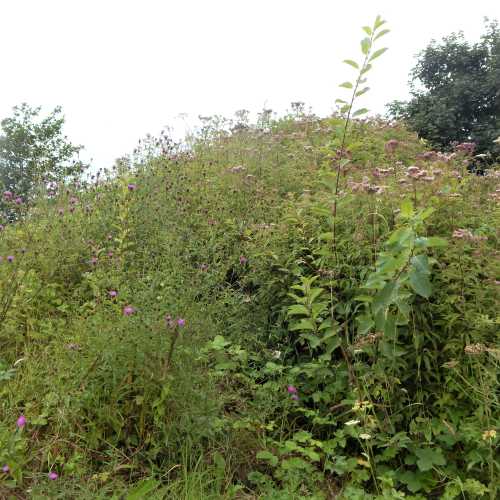 Above: This large wild verge is a first class restaurant for bees and other pollinators. At various times of the year, it provides an abundance of knapweed, hemp agrimony, thistles, brambles, various umbellifers, ragwort, burdock, buttercups and clover.
Above: This large wild verge is a first class restaurant for bees and other pollinators. At various times of the year, it provides an abundance of knapweed, hemp agrimony, thistles, brambles, various umbellifers, ragwort, burdock, buttercups and clover.Geographical locations
This species is found across the United States and Canada, Europe, and northern Asia.
Nesting habits of Halictus rubicundus
These bees, like bumble bees and honey bees, are eusocial. Females nest in light soils, often in groups, but sometimes singly. Individual nests are founded by a mated female (or 'queen') in the spring.
She will lay eggs, and raise a colony of workers, who will then forage for nectar and pollen for new males and females (the next colony foundresses, or 'queens').
Wilson & Messinger Carril in The Bees In Your Backyard highlight research that suggested nests may have multiple entrance and exit holes. They also note that a worker can leave a nest and establish a separate colony, and that if a 'queen' dies, any worker can take her place.
Females are maintained in a 'subordinate' worker role by feeding on less pollen, resulting in smaller bees that are also less likely to survive the winter.
Curious fact
Bees need water and will collect it from a variety of locations.
However, Halictus, along with Laslioglossum are sometimes known as 'sweat bees' - in the US at least, because they are known to sometimes sip sweat from humans!
Some species of stingless sweat bee will even congregate around the eyes of humans to get at tears! Read about how sweat bees got their name.
If you found this page helpful or interesting, I'd really be grateful if you would share it with others - if not this page, perhaps another, such as Gardening For Bees.
Thank you so much :) .
